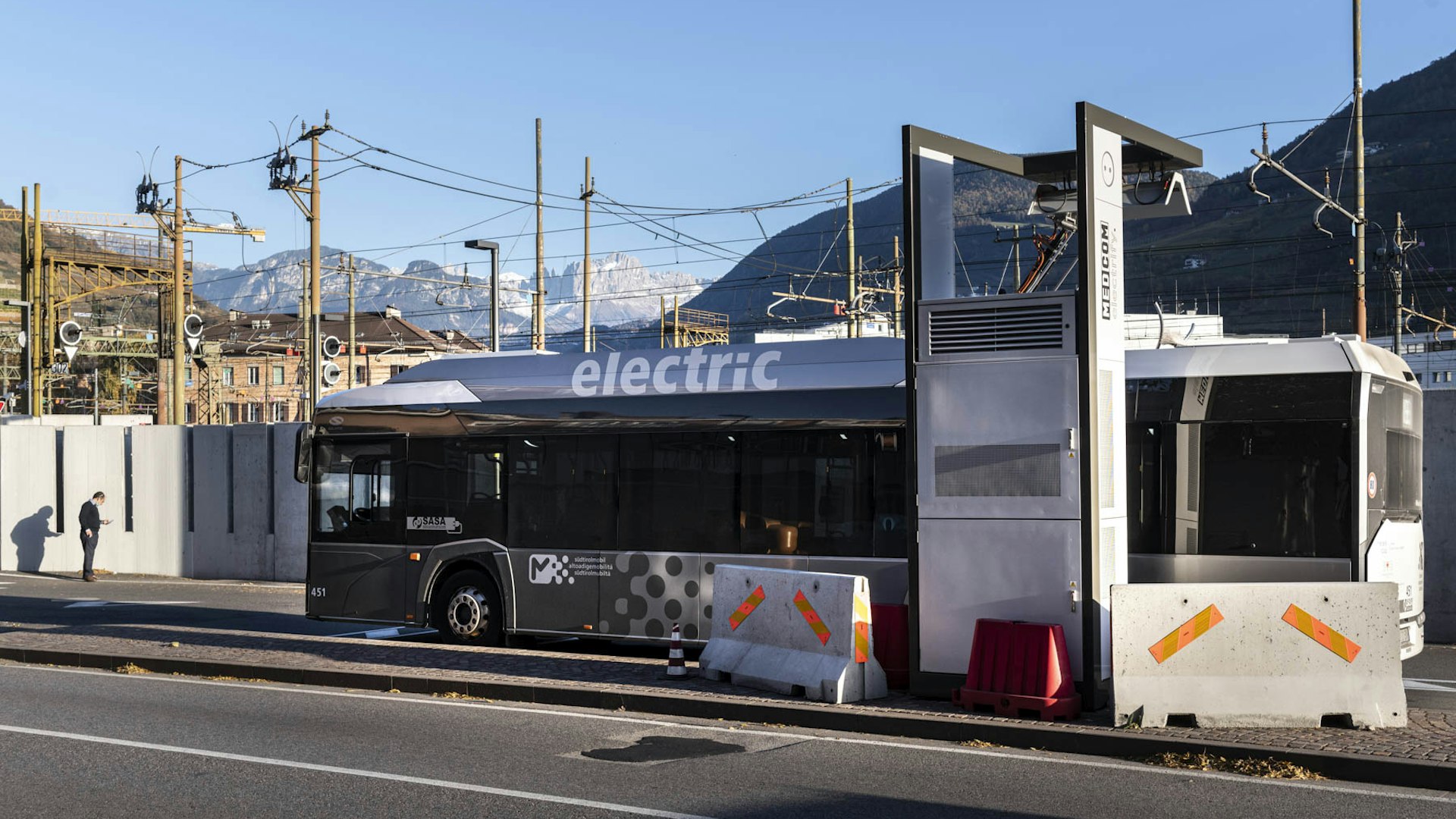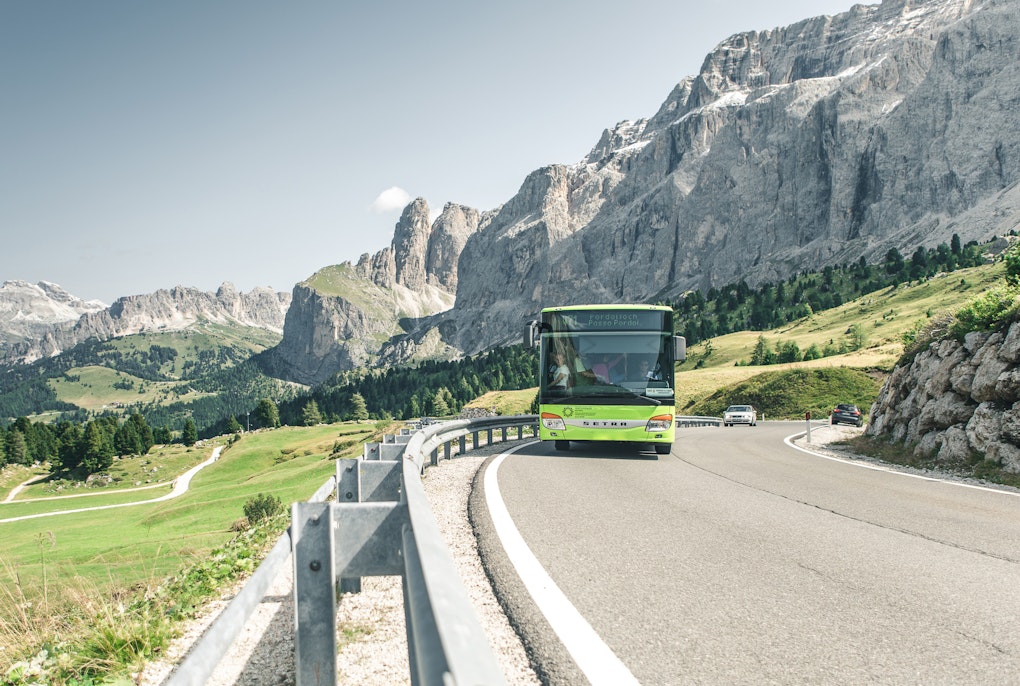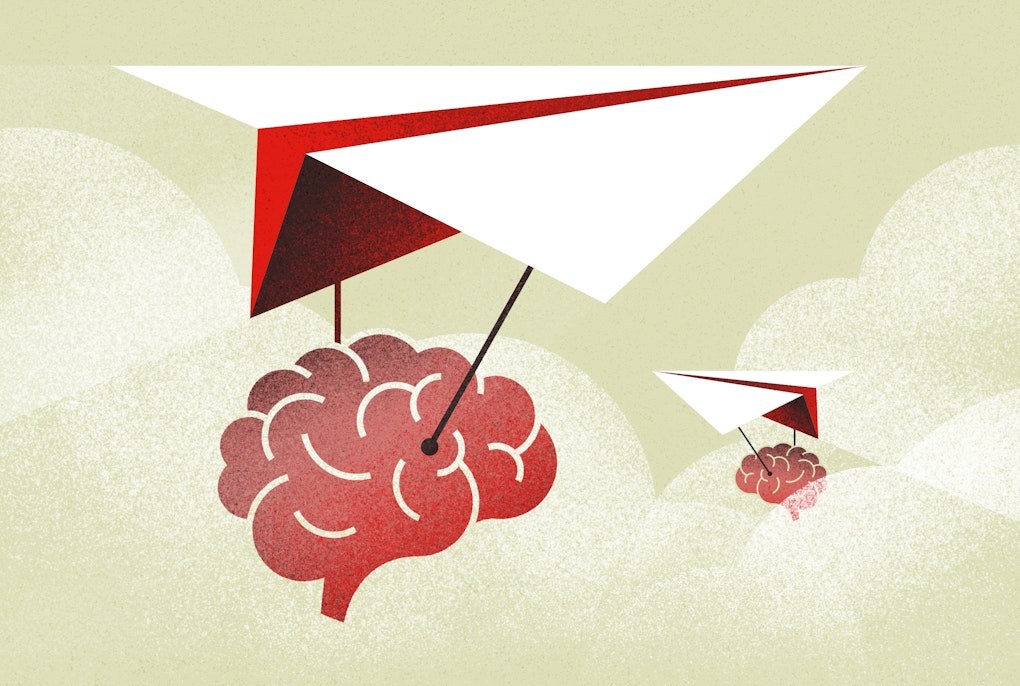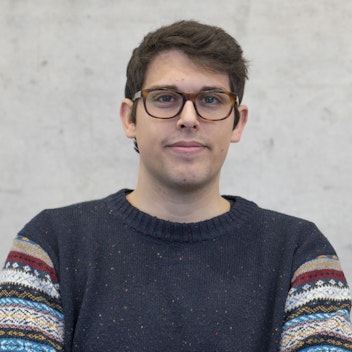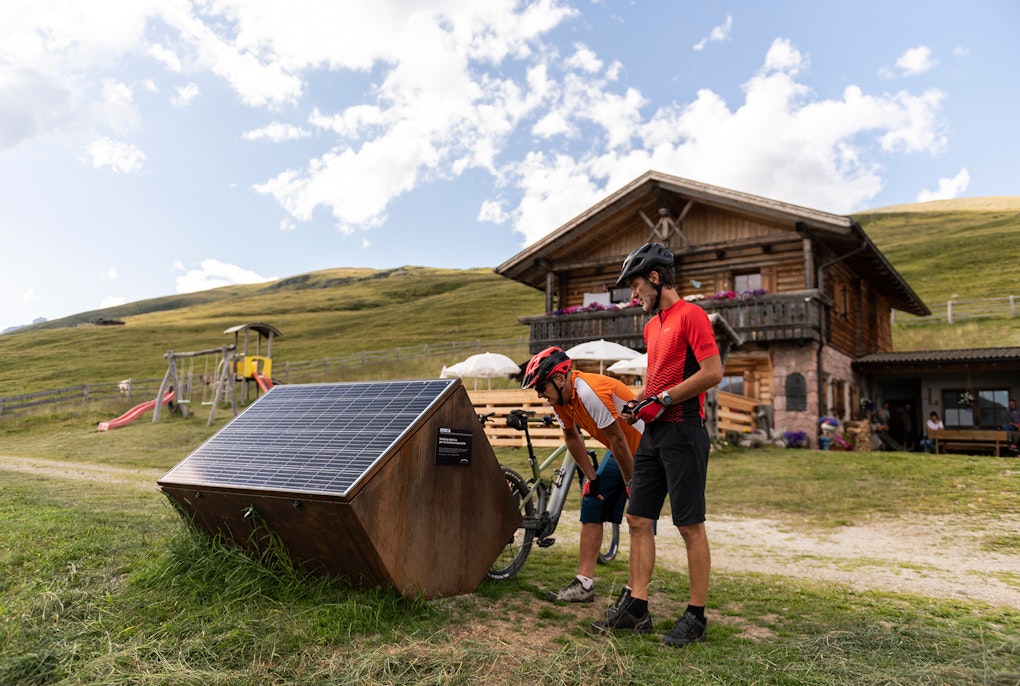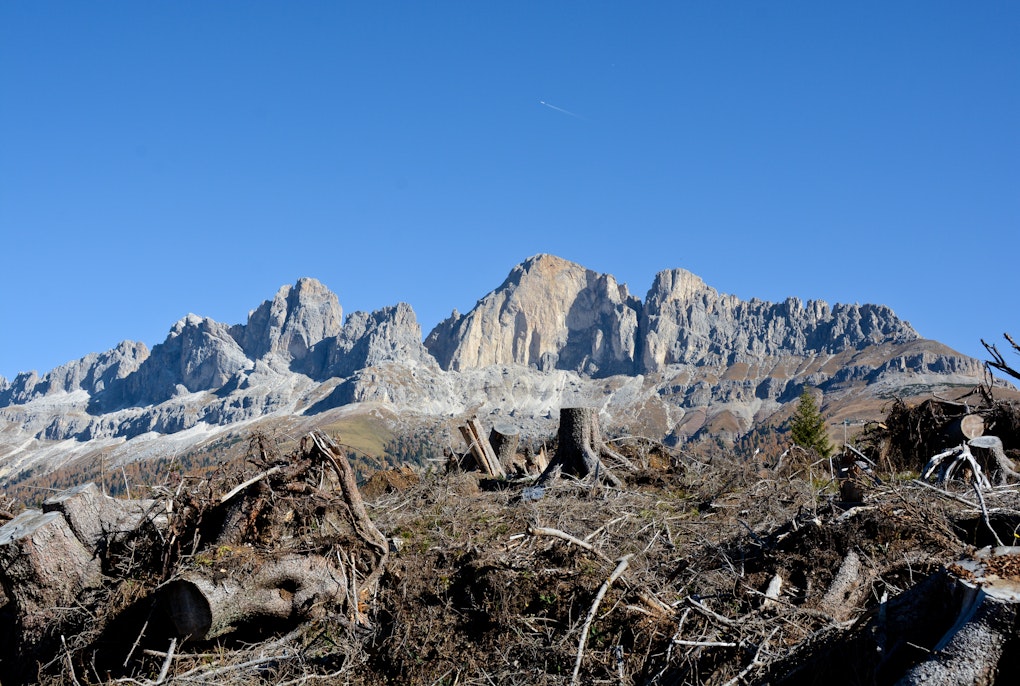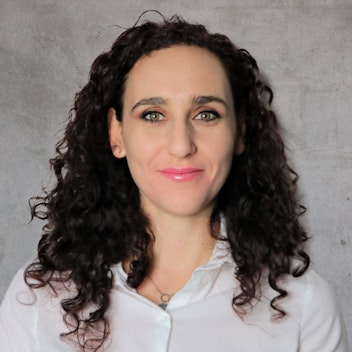magazine_ Article
Data and scenarios for zero-emission buses
Investigating the possibility of eliminating fossil fuels from public transportation
Is it possible to transform an entire fleet of public buses to zero-emission vehicles? A team from Eurac Research has been working together with local transport companies and other stakeholders to develop a simulation model and collect real world data to understand the feasibility of this type of choice. The initiative has brought the entities together under the aegis of several European projects.
Currently, public transport in the Alps consists of road vehicles powered mainly by diesel, natural gas, or hybrid with only a small percentage of zero-emission vehicles that are electric or hydrogen-powered.
The feasibility studies developed at Eurac Research assess the parameters needed to transform the entire fleet of public road transport to make it emission-free. The questions investigated concern how much energy the buses need to run on and what technologies are worthwhile to implement to do this. Further research seeks solutions to understanding what types and sizes of batteries should be installed in the case of electric vehicles and where charging infrastructure should be placed as well as and what kind of charging and refueling infrastructures are needed? A final analysis also reviews the impact of these vehicles in terms of their overall life cycle.
In the projects regarding the South Tyrol case study, the following local stakeholders were involved: STA - Strutture Trasporto Alto Adige SpA, SASA SpA, Neogy, and IIT Bolzano H2 South Tyrol.
“The goal of this series of studies is to provide all stakeholders with real-world data, analyses specific to their vehicle fleets, and in-depth information on the lifecycle of the technologies. This is all information that enables more informed decisions”
Wolfram Sparber, director of the Institute for Renewable Energy
Starting with facts: monitoring actual consumption
Many administrations and public transport companies of today are asking if the transition to zero emissions is really possible. And if they are, what the economic and ecological impacts of such a transition would be.
“In order to be able to answer to this, we need to understand the technologies, and we need to carry out very precise studies on the fleet and also on specific cases while evaluating the type of use, conformation of terrain. We look at altitude which is of course a very important element in the Alps as well as the climatic conditions too,” explains Wolfram Sparber, director of the Institute for Renewable Energy at Eurac Research. “While a lot of simulation work has been undertaken in scientific literature in recent years, real data on the actual fleets is very scarce.”
In light of this, experts from Eurac Research developed a model that not only took all aforementioned parameters into account, but also collected real monitoring data on the zero-emission vehicles used in South Tyrol for the past few years. The study was able to rely on a special feature of Bolzano’s public transport, namely the zero-emission buses employed there use two different technologies, hydrogen and electric. “Usually, the little monitoring data available is very fragmented. In South Tyrol we are lucky that the different technologies are all being used in the same context; this uniqueness is another element that makes the published data very interesting.”
Monitoring zero-emission buses in Bolzano: the results
Together with SASA S.p.A./AG ̶ the concessionary company for public road transportation in the urban and suburban lines of the cities of Bolzano, the research team collected data from 21 buses not using fossil fuels: five electric and 16 hydrogen buses. The data was collected between January 2021 and April 2022, a period in which the fleet traveled about 537,500 km (56 percent of which was covered by the hydrogen buses) in the municipalities of Bolzano and Laives.. The data was then analyzed and compared with international analyses and benchmarks.
“The transition to zero-emission public transport is not just about the vehicles: it’s a system change. Vehicles and charging and refueling infrastructure have to thought of together"
Wolfram Sparber, director of the Institute for Renewable Energy
“The study shows how both technologies can be used seamlessly and on a daily basis for public transportation: both work, are more efficient than fossil-fuel buses, and produce zero on-site emissions,” comments Aaron Estrada, one of the team's researchers. “This is critical with regard to policies that aim to improve air quality at local level.”
The study also showed the distinctive advantages of hydrogen and electric buses. On the one hand, the high efficiency of electric buses allows for reduced energy consumption compared to hydrogen buses for the same mileage. On the other hand, hydrogen buses have shown less dependence on weather conditions. In fact, in winter conditions the increase of the consumption of electric buses is higher, as part of the energy is used for heating them.
“But the transition to zero-emission public transport is not just about the vehicles: it’s a system change,” Wolfram Sparber warns. “It's not only new vehicles, but also the infrastructure that is needed to fuel them. The two aspects need to be thought of together, otherwise the risk is that you will spend a lot and end up with a suboptimal solution.” For this, the research team took into account many other factors: such as where to place the charging infrastructure and what kind of technical specifications are needed.”
And the battery production?
In another study, the research team delved deeper. Looking at daily use, zero-emission buses prove to be more efficient than diesel-powered ones, but does that apply to the entire life cycle of these technologies too?
In other words, how much does the production and disposal phase of electric and hydrogen buses cost in terms of energy and emissions? “We have seen how in the case of buses, the daily use phase remains the one with by far the highest energy consumption and therefore is the one that should be focused on,” comments Gianluca Grazieschi, a researcher at the Renewable Energy Institute. All the other phases - where, for example, battery production and disposal are included - only represent a small percentage, coming in at well under 10 percent of overall energy consumption and emissions.
“Ultimately it is certainly important to consider the whole life cycle of the technology, but surely the most relevant part remains in understanding what energy the vehicle uses and how efficient it is in its daily use,” the researcher concluded.
And what do bus drivers think?
In addition to the quantitative analysis which covered efficiency, fuel consumption, and cost per kilometer, a study of driver and driver satisfaction was also performed.
“Often the social and human aspects are not considered when it comes to adopting innovative technologies, but staff acceptance of transformations toward more sustainable systems is one of the important variables to take into account”
Jessica Balest, sociologist at the Institute for Renewable Energy
“Drivers often have to change the type of vehicle they drive, and perception of comfort in driving zero-impact buses must be taken into account,” comments sociologist Jessica Balest, who contributed to the study. “Often the social and human aspects are not considered when it comes to adopting innovative technologies, but staff acceptance of transformations toward more sustainable systems in the public transport sector is one of the important variables to take into account.”
The perception and satisfaction level of the drivers was found to be positive and stress levels also seemed to be reduced, as well due to decreased noise and vibration. The belief that the use of hydrogen and electric buses in public transport in Bolzano is something innovative and somewhat pioneering was also highlighted.
The feasibility of 100% zero-emission public transport
“Right now, the important thing is to implement the transition to zero-emission transport. And to do it quickly,” Wolfram Sparber underlines “From this perspective, this series of studies adds an extra piece by providing all stakeholders with real data, specific analyses for their vehicle fleets, and in-depth information on the life cycle of the technologies. All the information needed to enable more informed decision-making.”
The electrification of the transportation sector is a major driver of the decarbonization of energy and mobility systems and allows utilization of local renewable energy sources. With this in mind, public bus fleets can also contribute to a rapid reduction in CO2 emissions.
Transformation in the public transport sector can extend beyond road transport. Researchers at Eurac Research have also studied, public water transport in Scandinavia, where in some contexts electric ferries are being used. These types of vehicles could also be used effectively in the Alpine region. “With regard to electric mobility on water there is less experience and less choice of models, but our simulations show that it is definitely an option that could be applied to Italian lakes. These technologies would offer zero-emission navigation which is definitely quieter and more comfortable than the ones currently employed,” comments Matteo Prina, researcher at the Institute for Renewable Energy.
The models developed by Eurac Research can not only also be applied in the evaluation of public transport in other regions such as in the case of the province of Verbano Cusio Ossola but also in contexts that may appear completely different. One example in South Tyrol is that of milk collection, which runs on somewhat similar logic to public transport: predetermined routes, with similar timings on a daily basis. Similarly, many other transportation systems operate in the same way: suppliers, bakers, and other medium to large production activities.
Could these mobilities be rethought to use zero-emission vehicles too?
 technical documentation
technical documentationRead more: scientific papers
Eurac Research studies and models have been published in the following scientific journals:
• Aaron Estrada Poggio, Jessica Balest, Alyona Zubaryeva, Wolfram Sparber, “Monitored data and social perceptions analysis of battery electric and hydrogen fuelled buses in urban and suburban areas”, Journal of Energy Storage, Vol 72, 2023. https://doi.org/10.1016/j.est.2023.108411.
• Gianluca Grazieschi, Alyona Zubaryeva, Wolfram Sparber, “Energy and greenhouse gases life cycle assessment of electric and hydrogen buses: A real-world case study in Bolzano Italy,” Energy Reports, Vol. 9, 2023. https://doi.org/10.1016/j.egyr.2023.05.234.
• Wolfram Sparber , Andrea Grotto, Pietro Zambelli, Roberto Vaccaro, and Alyona Zubaryeva. "Evaluation of Different Scenarios to Switch the Whole Regional Bus Fleet of an Italian Alpine Region to Zero-Emission Buses" World Electric Vehicle Journal 14, no. 4: 91, 2023. https://doi.org/10.3390/wevj14040091
• D’Alonzo, Valentina, Pietro Zambelli, Samuele Zilio, Alyona Zubaryeva, Andrea Grotto, and Wolfram Sparber. "Regional Infrastructure Planning Support Methodology for Public and Private Electrified Transport: A Mountain Case Study" Applied Sciences 13, no. 12: 7181, 2023. https://doi.org/10.3390/app13127181
• Prina, Matteo Giacomo, Alyona Zubaryeva, Giuseppe Rotondo, Andrea Grotto, and Wolfram Sparber.. "Optimal Fleet Transition Modeling for Sustainable Inland Waterways Transport" Applied Sciences 13, no. 17: 9524, 2023. https://doi.org/10.3390/app13179524
